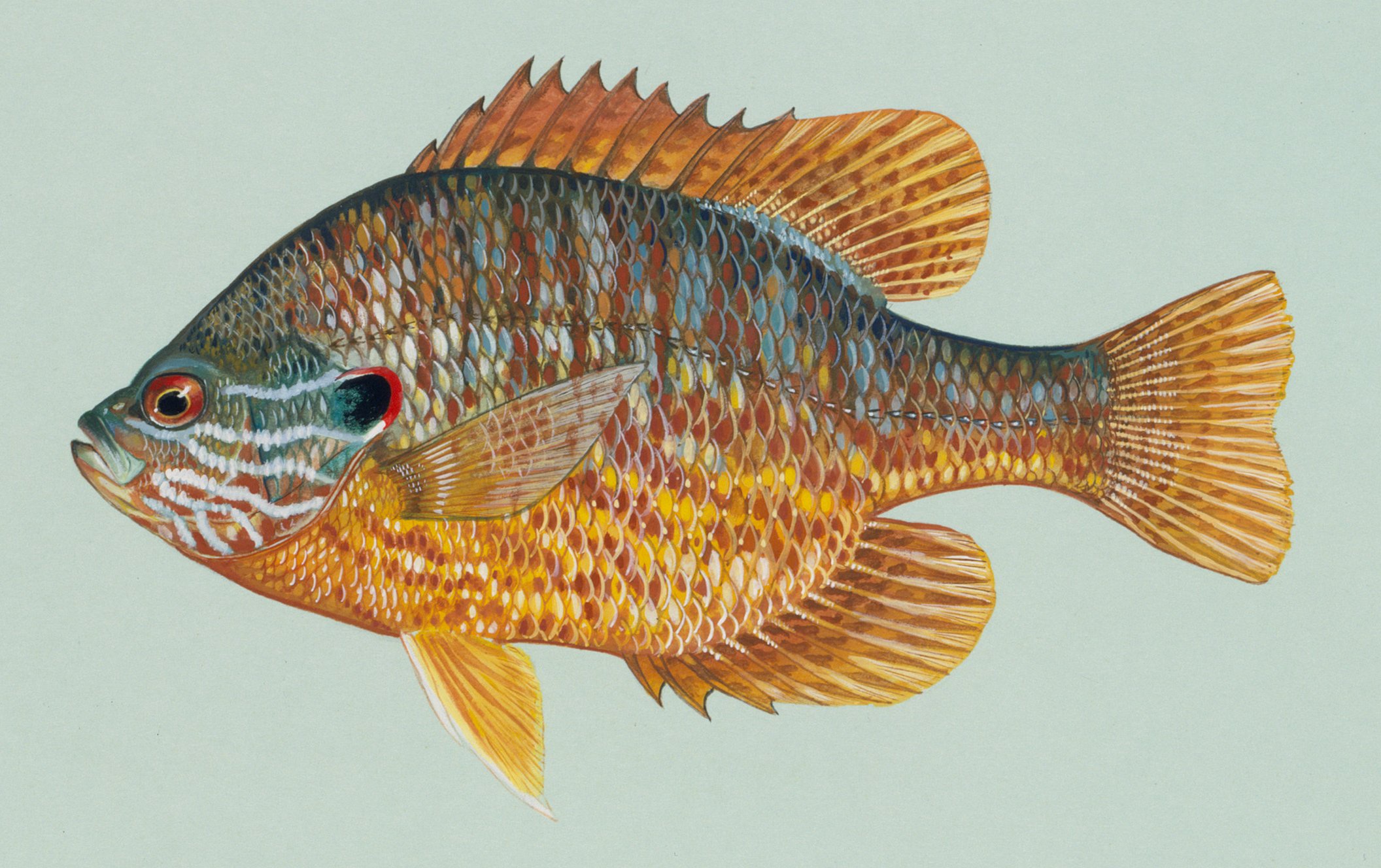- Pumpkinseed
Taxobox
name = Pumpkinseed
status = secure

image_width = 250px
regnum =Animal ia
phylum = Chordata
classis =Actinopterygii
ordo =Perciformes
familia =Centrarchidae
genus = "Lepomis "
species = "L. gibbosus"
binomial = "Lepomis gibbosus"
binomial_authority = (Linnaeus,1758 )The pumpkinseed ("Lepomis gibbosus") is a
freshwater fish of the sunfish family (Centrarchidae ) of orderPerciformes . It is native to northeasternNorth America , fromNew Brunswick toSouth Carolina but it has been introduced elsewhere in North America as well as throughout much of Europe where it is considered aninvasive species .Pumpkinseeds reach a maximum length of about 40 cm (16
inch es), although sizes of 15–20 cm (6–8 inches) are more typical. Weights are normally less than 450gram s (1 pound), although larger specimens can be encountered. The fish present an oval silhouette and are very compressed laterally; it is this body shape, resembling the seed of apumpkin , which provides them with their common name. The coloration includes orange, green, yellow, or blue speckles on an olive back, yellow sides and a yellow to orange belly and breast. As with all centrarchids, they have sharp spines in the dorsal and anal fins.Pumpkinseeds prefer shallow water with some weed cover. They are often typical of ponds and small lakes, preferring water temperatures of 4–22 °C (39–72 °F). They are active during the day and rest near the bottom at night.
These fish reproduce rapidly and are low on the
food chain . They eat a variety ofinsects , includingmosquito larvae , along with smallmollusc s andcrustacean s. They also feed on smaller fish, including smaller pumpkinseeds. In the shallow areas of which they are typical, the fish exploit the entirewater column from the bottom to surface. In turn, they provide food forbird s andmammal s (includinghuman s).Sexual maturity occurs at age two. Males prepare nests in colonies on gravel bottoms in late spring. The males are territorial and chase even early-arriving females away. When a female reaches a nest, she is joined by the male, and eggs are deposited in a cloud ofmilt . The eggs settle and stick to the pebbles. The female departs as soon as the eggs have been deposited. Males may welcome several females over several days. The male guards the nest as the eggs hatch in a few days. The males continue to guard the offspring, herding them into a ball-like cloud. After a week or two, the young gain sufficient energy and maintaining the order of the cloud becomes impossible at which point the offspring disperse and the male departs the nest. Pumpkinseeds are known to interbreed with the closely-relatedbluegill , which they resemble in form and coloration.The pumpkinseed, like other sunfishes, is very popular with anglers. The fish is often the first one caught by young anglers. The fish is considered to be a fine food fish although it is less prized than the bluegill. Pumpkinseeds feed all day and can be caught with live bait or with small lures. They actively fight the line as they are reeled in. This species is regarded as a
panfish due to its size and edibility."L. gibbosus" is known by many other common names, including punky, pond perch, sun bass, "crapet-soleil" (in
Québec ), kivver or kivvie(New England ), yellow sunfish, and simply sunfish (or "sunny"). The specific epithet, "gibbosus," derives from theLatin "gibb(er)ōsus" (hunch backed).References
*
*ITIS : [http://www.itis.usda.gov/servlet/SingleRpt/SingleRpt?search_topic=TSN&search_value=168144 "Lepomis gibbosus"]
*
*cite book |last=Rice |first=F. Philip |title=America's Favorite Fishing-A Complete Guide to Angling for Panfish |year=1964 |publisher=Harper Row |location=New York
*cite book |last=Rice |first=F. Philip |title=Panfishing |year=1984 |publisher=Stackpole Books |location=New York |isbn=0-943822-25-4
Wikimedia Foundation. 2010.
